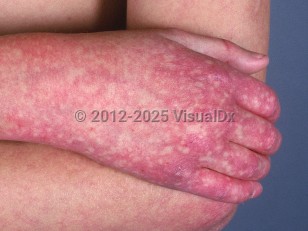Rothmund-Thomson syndrome in Adult
Alerts and Notices
Important News & Links
Synopsis

Rothmund-Thomson syndrome, or poikiloderma congenitale, is an inherited disorder with photosensitivity as a prominent feature. Disease onset is generally between a few months to 2 years after birth and is characterized by poikiloderma, especially of the face and extremities, and sparse hair, with variable extracutaneous findings including cataracts, hypogonadism, short stature, mid-face hypoplasia, and other skeletal abnormalities. Juvenile subcapsular cataracts develop in more than half of affected children.
The disease is autosomal recessive and is due to mutations in the RECQL4 helicase gene, which is involved in DNA repair. DNA helicase dysfunction results in an increased susceptibility to cancer, particularly osteosarcoma and skin cancer. Myelodysplasia and hematologic malignancy are rare. In the absence of malignancy, lifespan is generally normal.
The disease is autosomal recessive and is due to mutations in the RECQL4 helicase gene, which is involved in DNA repair. DNA helicase dysfunction results in an increased susceptibility to cancer, particularly osteosarcoma and skin cancer. Myelodysplasia and hematologic malignancy are rare. In the absence of malignancy, lifespan is generally normal.
Codes
ICD10CM:
Q82.8 – Other specified congenital malformations of skin
SNOMEDCT:
69093006 – Rothmund-Thomson syndrome
Q82.8 – Other specified congenital malformations of skin
SNOMEDCT:
69093006 – Rothmund-Thomson syndrome
Look For
Subscription Required
Diagnostic Pearls
Subscription Required
Differential Diagnosis & Pitfalls

To perform a comparison, select diagnoses from the classic differential
Subscription Required
Best Tests
Subscription Required
Management Pearls
Subscription Required
Therapy
Subscription Required
References
Subscription Required
Last Reviewed:06/10/2018
Last Updated:01/23/2022
Last Updated:01/23/2022
Rothmund-Thomson syndrome in Adult

